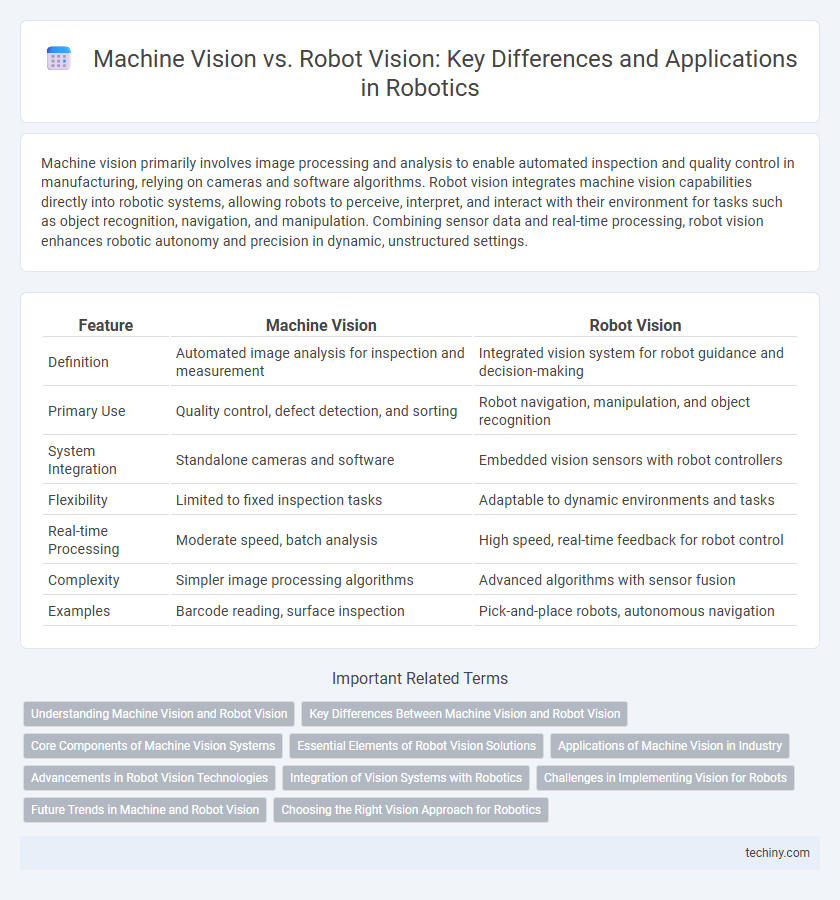Machine vision primarily involves image processing and analysis to enable automated inspection and quality control in manufacturing, relying on cameras and software algorithms. Robot vision integrates machine vision capabilities directly into robotic systems, allowing robots to perceive, interpret, and interact with their environment for tasks such as object recognition, navigation, and manipulation. Combining sensor data and real-time processing, robot vision enhances robotic autonomy and precision in dynamic, unstructured settings.
Table of Comparison
| Feature | Machine Vision | Robot Vision |
|---|---|---|
| Definition | Automated image analysis for inspection and measurement | Integrated vision system for robot guidance and decision-making |
| Primary Use | Quality control, defect detection, and sorting | Robot navigation, manipulation, and object recognition |
| System Integration | Standalone cameras and software | Embedded vision sensors with robot controllers |
| Flexibility | Limited to fixed inspection tasks | Adaptable to dynamic environments and tasks |
| Real-time Processing | Moderate speed, batch analysis | High speed, real-time feedback for robot control |
| Complexity | Simpler image processing algorithms | Advanced algorithms with sensor fusion |
| Examples | Barcode reading, surface inspection | Pick-and-place robots, autonomous navigation |
Understanding Machine Vision and Robot Vision
Machine vision utilizes cameras and image processing algorithms to enable automated inspection, measurement, and guidance systems in industrial applications. Robot vision integrates machine vision with robotic systems to provide spatial awareness and real-time decision-making for tasks like object manipulation, navigation, and quality control. Understanding the synergy of machine vision sensors, AI-powered image analysis, and robotic control enhances precision and efficiency in modern automation workflows.
Key Differences Between Machine Vision and Robot Vision
Machine vision primarily involves image acquisition and processing systems designed for inspection, measurement, and guidance in automated industries, focusing on extracting detailed visual information through cameras and sensors. Robot vision integrates machine vision capabilities directly into robotic systems, enabling real-time perception, navigation, and dynamic interaction with the environment for tasks such as object recognition and manipulation. Key differences lie in machine vision's emphasis on static analysis and quality control, whereas robot vision concentrates on adaptive feedback and motion control within robotic operations.
Core Components of Machine Vision Systems
Machine vision systems rely on core components such as digital cameras, image processing software, and lighting to capture and analyze visual information for automated inspection and quality control. In contrast, robot vision integrates these machine vision elements with robotic sensors and control units to enable real-time decision-making and manipulation tasks. The synergy between high-resolution imaging sensors, advanced algorithms, and precise lighting techniques forms the backbone of effective machine vision performance in industrial robotics.
Essential Elements of Robot Vision Solutions
Robot vision systems integrate advanced sensors, real-time image processing, and AI algorithms to enable robots to perceive and interpret their environment with high accuracy. Essential elements include 3D cameras, lighting control, and robust vision software capable of object recognition, tracking, and spatial analysis. These components work together to support automated decision-making and precision tasks in manufacturing, logistics, and quality control.
Applications of Machine Vision in Industry
Machine vision is extensively used in industrial applications for automated inspection, quality control, and robotic guidance, ensuring precision and efficiency on manufacturing lines. It enables defect detection in electronics assembly, measurement in automotive production, and sorting in food processing by capturing and analyzing visual data. Unlike broader robot vision systems, machine vision is often integrated into fixed stations to perform high-speed, repeatable tasks critical for maintaining product standards.
Advancements in Robot Vision Technologies
Advancements in robot vision technologies have significantly enhanced the accuracy and adaptability of automated systems by integrating deep learning algorithms and 3D imaging sensors. Unlike traditional machine vision, which primarily relies on fixed cameras for inspection tasks, robot vision enables dynamic interaction with environments through real-time object recognition and spatial awareness. These innovations facilitate more complex applications such as autonomous navigation, precise manipulation, and improved defect detection in industrial robotics.
Integration of Vision Systems with Robotics
Machine Vision systems use cameras and algorithms for quality inspection and measurement, while Robot Vision integrates these systems directly with robotic arms to enable real-time spatial awareness and adaptive manipulation. Integration of vision systems with robotics enhances precision in tasks such as object recognition, path planning, and error correction, leading to improved automation efficiency. Advanced calibration techniques and communication protocols like ROS (Robot Operating System) ensure seamless interaction between vision sensors and robotic controllers.
Challenges in Implementing Vision for Robots
Implementing vision systems in robotics confronts challenges such as varying lighting conditions, occlusions, and real-time processing constraints that affect accuracy and speed. Machine vision often relies on controlled environments and fixed cameras, whereas robot vision must handle dynamic scenes and moving viewpoints, requiring advanced algorithms for object recognition and depth perception. Integration with robotic control systems demands robust sensor fusion and adaptive learning to maintain performance across diverse operational contexts.
Future Trends in Machine and Robot Vision
Future trends in machine vision and robot vision emphasize enhanced AI integration and real-time data processing, driving improved accuracy and adaptability in automated systems. Advances in sensor technology, such as 3D imaging and hyperspectral cameras, enable more precise object recognition and environment mapping for robots. The convergence of cloud computing and edge processing is set to optimize machine vision applications, facilitating smarter, faster decision-making in industrial and service robotics.
Choosing the Right Vision Approach for Robotics
Machine vision emphasizes high-speed image processing and precise defect detection, making it ideal for industrial quality control and assembly lines, while robot vision integrates sensory input for real-time decision making and navigation in dynamic environments. Selecting the right vision approach depends on specific application requirements such as environmental complexity, processing speed, and task flexibility. Advanced algorithms in robot vision systems enhance autonomous operation, whereas machine vision systems excel in consistent, high-accuracy inspection tasks.
Machine Vision vs Robot Vision Infographic

 techiny.com
techiny.com